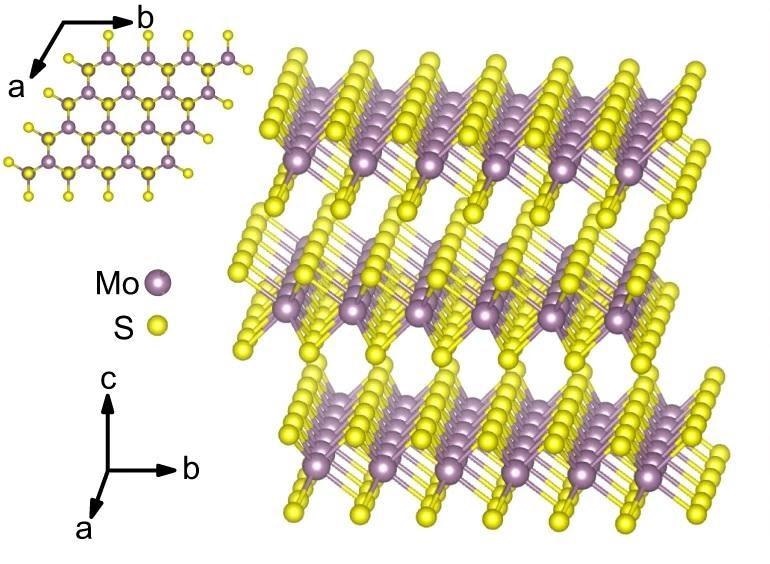Mar 4 2021
For the first time, scientists from the Center for Photonics and Two-Dimensional Materials at Moscow Institute of Physics and Technology (MIPT) have successfully measured enormous optical anisotropy in layered molybdenum disulfide crystals.
 Diagram of the structure of molybdenum disulfide. Image Credit: Nature Communications.
Diagram of the structure of molybdenum disulfide. Image Credit: Nature Communications.
The study involved collaborators from Spain, Sweden, Great Britain and Singapore, including Konstantin Novoselov—the Nobel laureate and co-creator of the world’s first 2D material.
According to the researchers, such transition metal dichalcogenide crystals can be used to substitute silicon in photonics. Birefringence with a massive variation in refractive indices, which is typical of these substances, will make it viable to design faster yet more minute optical devices. The study has been published in the Nature Communications journal.
The polarizing effects in optics were first observed by the Scandinavian Vikings, among others. The researchers found that when objects are viewed via Iceland spar (clear calcite), they appeared in double.
This phenomenon was subsequently referred to as birefringence. This kind of effect is caused by the asymmetrical arrangement of atoms in certain materials.
Consequently, a beam of light refracts in a different way in the material, based on the direction of its propagation, breaking into a pair of linearly polarized beams (the extraordinary and ordinary) and producing a doubled image.
But it was found that the birefringence phenomenon is highly practical. For instance, the Scandinavian Vikings utilized the double refraction of certain crystals for navigation purposes.
Existing liquid-crystal monitors create images by using the birefringence effect in liquid crystals. This phenomenon is even used for building wave plates, polarizers and other optical components.
The refractive indices of extraordinary and ordinary beams are preferred to vary as much as possible so that the required effect can be obtained when light travels through a thinner plate, and this would help decrease the size of the device, and in certain applications, boost its speed.
Recently, scientists have demonstrated that ultra-compact waveguides could be built with anisotropic materials to reach and also resolve the limit of diffraction. But this effect needs materials that have a birefringence value of more than 1.
To date, the hexagonal boron nitride h-BN and the BaTiS3 perovskite-layered crystals have maintained the record for birefringence (0.8). The wish to make contemporary optics increasingly compact has pushed the quest for natural materials that have large optical anisotropy of greater than 1.
In this respect, transition metal dichalcogenides are highly promising materials. Such compounds based on tellurium, selenium, sulfur, and 3D-elements of Mendeleev’s Periodic Table feature a layered structure.
Molybdenum disulfide (MoS2), for instance, contains alternating layers rotated with regard to one another by 1800 and these are held together by weak van der Waals forces, as shown in the above image.
“From the task of measuring the optical properties of molybdenum disulfide, we have arrived at a completely different problem—namely, to study anisotropy and find promising applications of the anisotropy of such crystals in photonics,” stated Georgy Ermolaev, a PhD student at MIPT and the first author of the study, explaining the authors’ motivation.
The anisotropic structure could not impact the optical properties of the material and this fact was already known in the second half of the 20th century. But quantitative measurements of the anisotropy were not available and this was because of, among other things, significant experimental challenges.
Hence, to resolve these difficulties, the team integrated techniques of both far and near electric fields. To put this in simple terms, apart from irradiating the material at various angles and identifying the signal, the researchers analyzed how the waveguide modes propagated in the material.
This method allows the team to explicitly establish the birefringence of the material, which is up to 3 times in the visible range and 1.5 in the near-infrared. Such values are many times greater than those of earlier record-breakers.
We used a combination of techniques—spectral ellipsometry and near-field optical microscopy and verified our data with numerical calculations. The work required the efforts of a large number of scientists from different scientific teams in different countries and with different competencies. For all of us, this work was the beginning of large-scale research on anisotropic transition metal dichalcogenides nanophotonics.
Aleksey Arsenin, Leading Researcher, Moscow Institute of Physics and Technology
The resultant data was compared with quantum calculations, which, to the investigators’ amazement created precisely the same outcome, thereby proving the accuracy of the engineered quantum mechanical model of layered materials and indicating that the concept and conclusions reported in the new article are relevant to the whole range of transition metal dichalcogenides.
For the world, the investigators have fully rediscovered a new group of materials that have large giant optical anisotropy.
The finding provides a more degree of freedom in the fabrication of compact photonic devices. For instance, it makes it viable to reach the limit of diffraction in optics for wave-guiding systems with typical dimensions of around 100 nm.
The study was headed by Professor Valentyn Volkov. In September 2019, he shifted from the University of Southern Denmark to MIPT to head the Center for Photonics and Two-Dimensional Materials.
Whereas previously we were limited to changes in geometry and effective refractive index to create new optical circuits and devices, giant anisotropy provides an additional degree of freedom to manipulate light.
Valentyn Volkov, Professor, Moscow Institute of Physics and Technology
“Unexpectedly, we found out that naturally anisotropic materials enable us to build compact waveguides literally on the edge of the diffraction limit. It gives us an opportunity to compete with silicon photonics. Now we can safely not only talk about post-silicon photonics but also implement it,” concluded Professor Volkov.
Journal Reference:
Ermolaev, G. A., et al. (2021) Giant optical anisotropy in transition metal dichalcogenides for next-generation photonics. Nature Communications. doi.org/10.1038/s41467-021-21139-x.